Traditional Saxon painted furniture — an element of intangible heritage
Jan 30, 2024
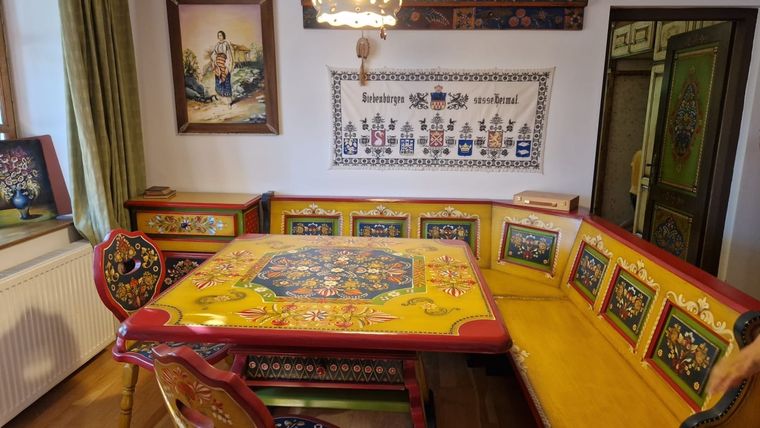
Home of Mircea Ungurean
The technique of producing painted furniture is a manufacturing process, with origins in the field of craftsmanship dating back long before the period of Transylvanian Saxon guilds. The handmade production of painted furniture is considered a traditional activity, as it developed gradually from the 14th century to the 20th century. The old furniture pieces made by the Saxon artists have acquired over time a historical, aesthetic and technical value, resulting from the structure and the elegance of the shapes and decorative elements, as well as the wood finishing techniques (Cionca, 2004; Cionca, 2004). However, when we talk about very old pieces of furniture, several decades or hundreds of years old, we are in fact talking about heritage artifacts with an inestimable cultural and economic value both nationally and internationally.
Painted furniture represents both a material and an immaterial form of heritage, because at the basis of the physical production of the furniture pieces are a series of immaterial aspects such as: ideas, knowledge, skills, spiritual beliefs, life experiences and feelings—aspects that are part of the immaterial sphere of human activity.
Given that furniture was designed to meet human needs, needs that have evolved over time, consequently the technique of its manufacture has also developed continuously with the evolution of human society. It has over time accumulated new functionalities and values, from the practical and functional to the aesthetic and artistic, thus becoming the expression of human culture and civilization in continuous development (Liu et al., 2019).
What we call heritage today, is the fruit of the folk creation of several dozens of generations that have developed these artistic creations in relation to economic development through the diversification of production, increasing demand and development of technologies (Horșia & Petrescu, 1971). The technique of painted Saxon furniture developed over more than 400 years, reaching its peak in the 19th century. Folk art in general, including the continuous development of furniture painting, could not be entirely prevented by bad times (Carpesius, 1987). During the Communist period, traditional handmade products were more expensive than industrially mass-produced ones. The explanation was that the craftsman’s workmanship is more expensive because it incorporates know-how that only he possesses. In this way, the survival of folk artists was encouraged and the national heritage was passed on.

House of Mircea Ungureanu, Cisnădioara
However, the decline of this ancient tradition began towards the end of the 20th century with the mass exodus of the Saxons to the Federal Republic of Germany. When we talk about painted furniture pieces as part of the intangible heritage of the Transylvanian Saxons, we have to consider the following aspects:
- cultural background,
- materials used,
- the modeling and style,
- modelling characteristics.
Cultural background
The Saxons are German settlers from today’s Rhineland, France, Luxembourg and Belgium who were brought to Transylvania by King Geza I in 1241 (Nägler). According to Roswith Capesius the beginnings of painted woodwork date back to the Middle Ages, long before it was practised in the organised guilds of Transylvania. However, most documentary sources are of the opinion that the guilds played a major role in the development and transmission of this craft, followed by the support of the Saxon churches and King Matthias Corvinus or some political events.
From the 14th century onwards, the Saxons organised themselves into craft guilds specialising in various fields, including the guild of timplers and carpenters who made furniture. The first guild of carpenters, which included all the craftsmen from southern Transylvania, was attested in 1589 (Beșliu & Frâncu, 2007: 42). It is considered to be the first organized structure to create painted furniture in the 15th century.
The guilds played an important role in the training of craftsmen. The Transylvanian guilds were obliged to make study trips to Austria, Bavaria, Tyrol or Italy (Butură, 1989) in order to learn and bring new techniques for processing materials and graphic concepts for decorating pieces of furniture. Travelling horse riders were assimilated as promoters of change and mutual cultural influences (Sedler, 2007).
Materials used (wood, paints, pigments and binders)
Since ancient times people have used the natural resources of the local environment as they were abundant and economically accessible. As Romania is a Carpathian country, forests occupied large areas, favouring the development of a wood culture and a tradition of wood processing. We talk about a tradition of wood because successive generations have accumulated a store of knowledge on the properties of wood essences, knowledge and empirical skills that helped them to specialize their craft activities.
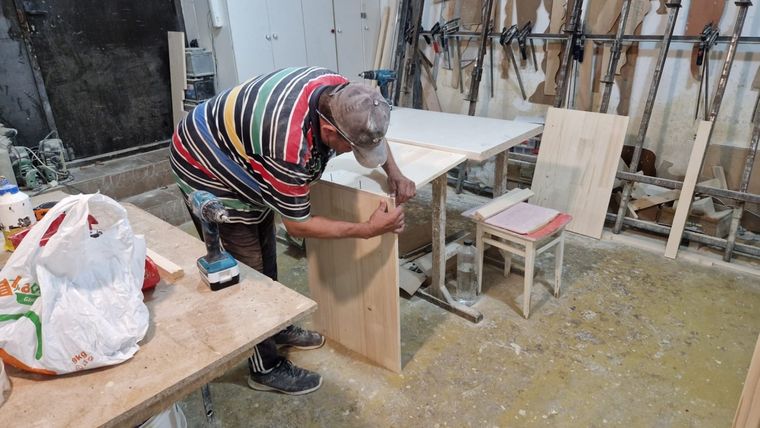
Mircea Ungureanu in workshop, Cisnădioara
The older paints used in wood painting were produced by the craftsman in his workshop. Lime, kaolin, chalk and alabaster were used in various combinations in the painting process. These minerals defined the colour. Thus they were obtained by various processes of burning powders from light ochre to English red. Green colour was obtained by quenching stones containing copper, while limestone, chalk and kaolin in combination with shell sand gave a brilliant white colour (Zelgy, 1980). By the 17th century we find mostly matte tones, because the necessary paints were easier to obtain. Ochre, white, brown, reddish-brown and olive-green compositions are not only specific to Transylvanian furniture painting of this century, but appear everywhere at the beginning of this artistic craft. Some very popular colours in ceramic decoration such as cobalt blue were introduced by the Saxons in furniture painting especially in the colouring of the background (Carpesius, 1987).
Modelling and style (modelling techniques, shapes, colours, ornaments, symbols and inscriptions)
The process of making painted furniture is a complex one which requires, in the first phase, the processing of wood using specific techniques and, in the second phase, wood painting techniques. The technique of shaping wood is not a new one. Starting with the Middle Ages, wood was processed by only two techniques: one specific to carpenters and one specific to woodworkers. The first technique involves the joining of pieces in the system ‘tongue and groove’, being made of cracked planks, cut with a saw, carved with an axe and a chisel and concluded in grooves and shingles fixed in wooden nails (Olaru, 2014), the wood was worked by carving.
The most beautiful pieces of Saxon furniture, however, date from the 17th century. XVII-XIX, being attributed as composition to the peasant baroque style, as they abound in shapes and colors. The most important decorative motifs were embodied in signs or symbols of ancient beliefs, legends or myths of mankind. The sun symbols, the tree of life, the image of man and the image of the horse are the oldest graphic expressions (Petrescu). In the evolution of ornamental symbolism, circumscribed by popular creation, it benefited from the Byzantine influence and the European cultural currents expressed in the period of the late Middle Ages, the Renaissance, the Baroque and Rococo periods resulting in a number of famous motifs: the tree of life, the umbrella figure, the great Nordic goddess, the mermaid, the bird. These are added to the local themes: variants of the tree of life, sun signs, the serpent and the dragon, the horse, anthropomorphic images (Petrescu).
Modelling features
Regarding the origins of this folk art, specialist studies have shown that the technique of painted furniture does not have its origins strictly in Transylvania, it does not belong exclusively to the peasant communities of the Transylvanian Saxons, and it did not develop in isolation but it is part of a wider cultural trend which had a significant geographical distribution in Europe, being found also in Southern Germany, Switzerland, Austria, Hungary, Romania, Czechoslovakia, Poland, Russia, and the Baltic States (Carpesius, 1987). In the Middle Ages, as populations migrated from one region to another, cultural influences circulated from one social group to another, and this was true of the Transylvanian Saxons. But the characteristics of wood carving and furniture making painted by Transylvanian Saxons varied in time and space. Thus, the tradition of painted furniture becomes the fruit of a continuous evolution on a European scale, as the Saxon craftsmen improved and perfected their practical technique according to the influences and trends of the time, to which they also brought their own contribution through personal additions (Carpesius, 1987). Thus, a number of common elements appear in terms of how the pieces of furniture were ornamented by taking over and adapting foreign folk heritage and adding elements of local specificity.
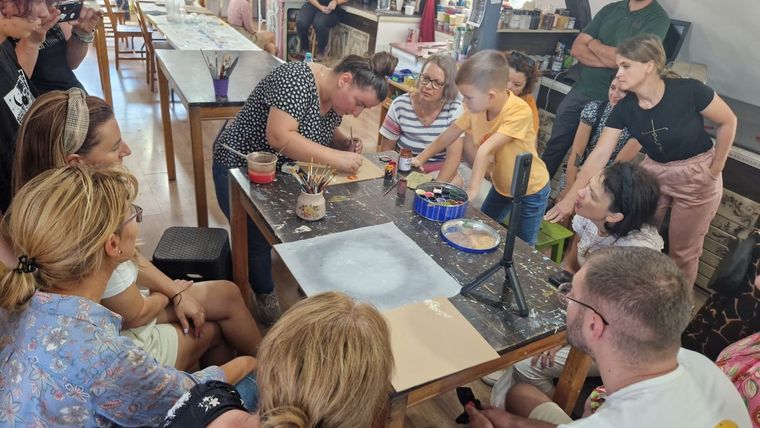
Pilot participants practice the technique learned from Maria
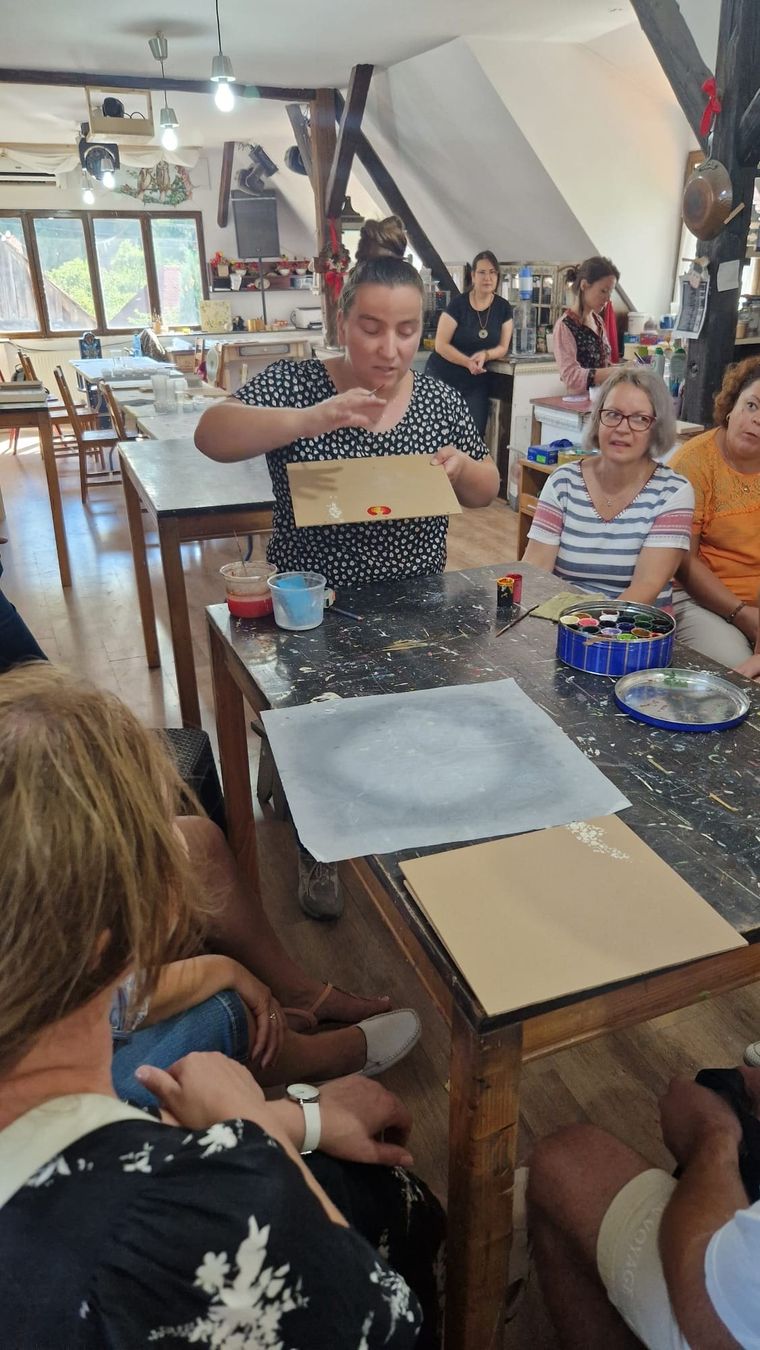
Maria explains the technique
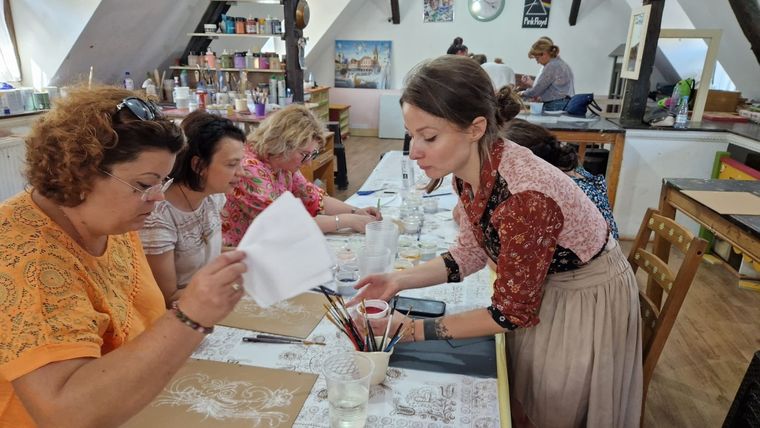
Carmen explains the technique and helps participants
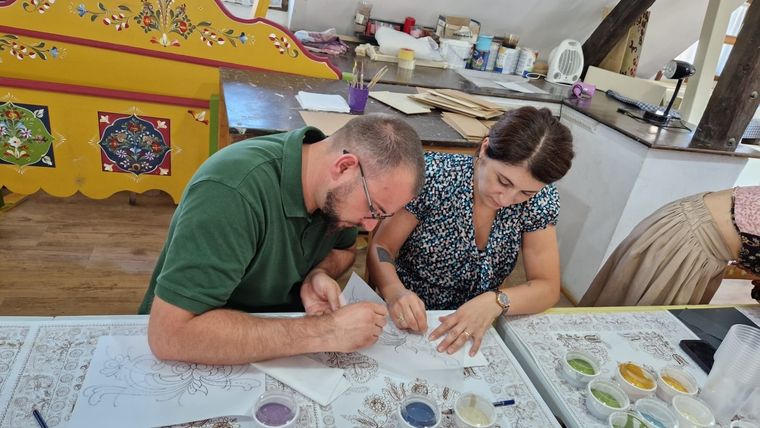
Carina and Iustin Herciu
References
- M. Cionca, Stiluri si ornamente la mobilier – Renasterea italiană (Styles and ornaments for furniture – Italian Renaissance), University Transilvania, Brasov, 2004, 120.
- M. Cionca, Proiectarea mobilei stil – Cassoni din Renasterea florentină (Design of art furniture – Cassoni from Florence Renaissance), University Transilvania, Brasov, 2004, 205.
- Horșia, O; Petrescu, P. Artistic Crafts in Romania, 1971.
- Capesius, R. Pictura pe lemn la saşii transilvăneni, Editura Kriterion,
- Beșliu,O.; Frâncu, R. Din istoria breslelor sibiene, Alba Iulia, Editura Altip, 2007, p. 42.
- Butură,V. Străvechi mărturii de civilizație românească, București, Editura Științifică și Enciclopedică, 1989, p. 333
- Sedler, I. Pictured furniture from South Transylvania. An international project at the house of arts in Sibiu. (August–November 2007).
- Zelgy,T. Siebenbürgisch-sächsische Möbelmalerei, Editura Kriterion, 1980.